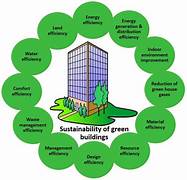The Process of Building Energy Conservation Designs
Introduction
As energy consumption continues to rise globally, the need for energy conservation in buildings has become more urgent. Buildings account for a significant portion of global energy use, and inefficient designs contribute to excessive energy waste. Energy conservation design is an approach that integrates efficient building materials, smart technology, and innovative construction methods to reduce energy consumption while maintaining comfort and functionality.
This article explores the process of designing energy-efficient buildings, covering key principles, design strategies, and advanced technologies that contribute to sustainable construction.
Understanding Energy Conservation in Buildings
Energy conservation design focuses on reducing energy demand while optimizing the efficiency of heating, cooling, lighting, and other building systems. The goal is to minimize reliance on non-renewable energy sources while enhancing environmental sustainability. This process involves:
- Passive Design Strategies: Utilizing natural resources to regulate indoor temperature and lighting.
- Active Systems Optimization: Implementing high-efficiency HVAC, lighting, and renewable energy solutions.
- Smart Energy Management: Using automated systems to monitor and control energy usage.
- Sustainable Materials: Incorporating eco-friendly materials that improve thermal performance.
Step-by-Step Process of Energy Conservation Design
1. Site Selection and Climate Analysis
Before designing an energy-efficient building, architects and engineers must analyze the local climate and environmental factors. Understanding wind patterns, solar orientation, and temperature variations helps determine:
- The best placement for windows and openings to maximize natural light.
- The need for shading devices to minimize heat gain in warm climates.
- The incorporation of thermal mass materials to regulate indoor temperatures.
2. Architectural Design and Passive Strategies
Passive design strategies minimize energy consumption by leveraging natural elements. These include:
- Building Orientation: Positioning the structure to maximize daylight while reducing direct heat exposure.
- Natural Ventilation: Designing cross-ventilation paths to reduce the need for air conditioning.
- Daylighting: Using skylights, large windows, and reflective surfaces to enhance indoor brightness without artificial lighting.
- Thermal Insulation: Installing high-quality insulation in walls, roofs, and floors to maintain indoor temperatures.
3. High-Performance Building Envelope
A building envelope (walls, roof, windows, and doors) plays a critical role in energy conservation. A well-designed envelope reduces heat loss in winter and heat gain in summer through:
- Double or Triple-Glazed Windows: Providing better thermal insulation.
- Low-E Coatings on Glass: Reducing infrared radiation and preventing heat loss.
- Green Roofs and Cool Roofs: Absorbing less heat and reducing urban heat island effects.
- Airtight Construction: Preventing unwanted air leaks and drafts.
4. Energy-Efficient HVAC Systems
Heating, Ventilation, and Air Conditioning (HVAC) systems are among the largest energy consumers in buildings. To enhance efficiency:
- Geothermal Heat Pumps use underground temperatures for heating and cooling.
- Variable Refrigerant Flow (VRF) Systems optimize temperature control based on room occupancy.
- Energy Recovery Ventilation (ERV) reuses exhaust air to pre-condition incoming fresh air.
- Zoned Heating and Cooling ensures energy is used only where needed.
5. Renewable Energy Integration
To reduce dependence on fossil fuels, many buildings now incorporate renewable energy sources such as:
- Solar Panels: Generating electricity from sunlight.
- Wind Turbines: Providing additional renewable power in windy areas.
- Solar Water Heating: Using solar collectors to heat water efficiently.
- Battery Storage Systems: Storing excess energy for later use, reducing reliance on the grid.
6. Smart Building Technologies
The use of intelligent energy management systems improves building performance by automatically optimizing energy consumption. Key technologies include:
- IoT-Based Sensors: Monitoring temperature, humidity, and occupancy levels to adjust energy use accordingly.
- Smart Thermostats: Learning user preferences to adjust heating and cooling efficiently.
- Automated Lighting Controls: Turning lights on or off based on natural daylight availability.
- Building Management Systems (BMS): Centralized platforms that control energy systems for optimal efficiency.
7. Water Conservation Strategies
Energy-efficient buildings also focus on water conservation, as water heating consumes significant energy. Strategies include:
- Rainwater Harvesting: Collecting rainwater for irrigation and flushing.
- Greywater Recycling: Treating and reusing wastewater from sinks and showers.
- Low-Flow Fixtures: Reducing water waste in faucets, toilets, and showers.
- Smart Irrigation Systems: Using weather data to optimize water usage for landscaping.
8. Sustainable Materials and Construction Techniques
The selection of materials greatly influences a building’s energy efficiency. Some sustainable materials include:
- Recycled and Locally Sourced Materials: Reducing carbon footprint from transportation.
- Bamboo and Cork: Rapidly renewable alternatives to traditional wood.
- Hempcrete and Straw Bale Construction: Providing excellent insulation properties.
- Prefabricated Components: Reducing waste and energy consumption during construction.
9. Performance Monitoring and Optimization
Even after construction, ongoing monitoring is essential to ensure energy efficiency. Building owners can:
- Use energy audits to identify areas for improvement.
- Install smart meters to track real-time energy consumption.
- Adjust HVAC settings and lighting schedules based on occupancy patterns.
- Upgrade outdated equipment to newer, more efficient models over time.
Benefits of Energy Conservation Design
Implementing energy-efficient building designs offers several long-term benefits:
- Lower Energy Costs: Reduced electricity and heating expenses.
- Reduced Carbon Footprint: Less reliance on fossil fuels and lower greenhouse gas emissions.
- Enhanced Comfort: Improved indoor air quality, temperature regulation, and natural lighting.
- Increased Property Value: Energy-efficient buildings attract higher resale and rental value.
- Compliance with Regulations: Meeting local and international sustainability standards (e.g., LEED, BREEAM, Energy Star).
Challenges and Future Trends
Despite its advantages, energy conservation design faces challenges such as:
- High Initial Costs: Some sustainable technologies require a higher upfront investment.
- Lack of Awareness: Many builders and homeowners are unfamiliar with available solutions.
- Technical Expertise: Proper implementation requires skilled professionals in energy-efficient construction.
However, future trends indicate a growing focus on net-zero energy buildings, 3D-printed sustainable homes, and AI-powered predictive energy management, making energy conservation more accessible and efficient.
Conclusion
Energy conservation in building design is a critical strategy for reducing energy consumption and promoting sustainability. By integrating passive design techniques, high-performance materials, smart technologies, and renewable energy, architects and engineers can create buildings that are both environmentally friendly and cost-effective. As advancements in technology continue, the future of energy-efficient construction looks promising, offering smarter, greener, and more sustainable living and working environments.


